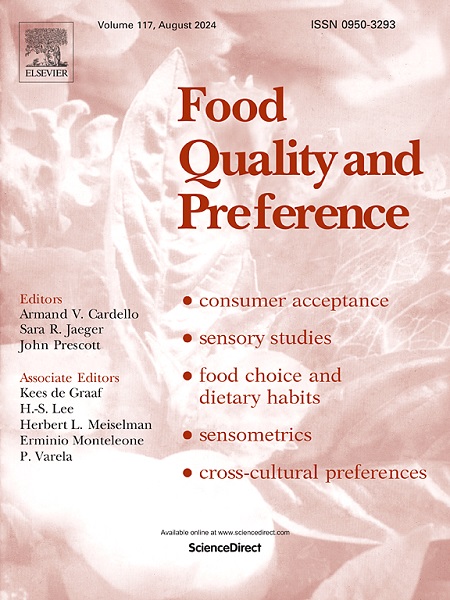Exploring the association of personal factors with affective responses to plant-based meat alternatives with consideration of their perceived similarity to meat.
IF 4.9
1区 农林科学
Q1 FOOD SCIENCE & TECHNOLOGY
引用次数: 0
Abstract
Plant-based meat alternatives (PBMAs) have gained popularity as perceived sustainable replacements for meat, yet consumption remains limited. Understanding how personality traits shape PBMA consumption experience is therefore essential. This study surveyed 140 New Zealand consumers, assessing behavioural traits and attitudes related to willingness to reduce meat consumption/increase PBMA consumption. Participants completed tasting sessions evaluating commercially available PBMA products, based on flavour, texture, overall liking and emotions evoked, and sample perceived similarity to meat. Participants reported their demographic information, dietary habits, and frequency of meat and PBMA consumption. Results showed that higher social status derived from PBMA consumption were linked with higher liking ratings and citation proportion of ‘hungry’ for PBMAs. However, high negative attitude towards vegetarianism/veganism was linked to higher citation proportion for ‘unhappy’ for wholefood samples, while lower citation proportion for ‘unhappy’ for somewhat meat-like samples. High meat attachment was associated with lower perceived similarity to meat in both meat-like and somewhat meat-like samples. Additionally, the high meat consumption group reported lower texture and overall liking for meat-like samples. High variety seeking consumers (VARSEEK scores) were positively associated with flavour and overall liking for wholefood samples. Based on dietary groups, meat avoiders, generally driven by environmental and animal welfare concerns, reported more negative emotions such as ‘unhappy’ when tasting wholefood PBMAs compared to omnivores and flexitarians, despite their strong ethical and environmental motivations. The research highlights the impact of consumer behavioural traits and attitudes on their PBMA perception and acceptance, providing valuable insights for improving product development.
探索个人因素与植物性肉类替代品的情感反应之间的关系,考虑到它们与肉类的感知相似性。
植物性肉类替代品(pbma)作为肉类的可持续替代品已经越来越受欢迎,但消费仍然有限。因此,了解人格特征如何塑造PBMA消费体验是至关重要的。这项研究调查了140名新西兰消费者,评估了与减少肉类消费/增加PBMA消费意愿相关的行为特征和态度。参与者完成了基于味道、质地、总体喜好和引发的情绪以及样品感知到的与肉类的相似性来评估市售PBMA产品的品尝环节。参与者报告了他们的人口统计信息、饮食习惯、肉类和PBMA消费的频率。结果表明,由于PBMA消费而获得的社会地位越高,对PBMA的“饥饿”的喜欢评级和引用比例越高。然而,对素食主义/纯素食主义的高度负面态度与天然食品样本中“不快乐”的引用比例较高有关,而在一些肉类样本中“不快乐”的引用比例较低。在类似肉类和有些类似肉类的样本中,高度的肉类依恋与较低的感知相似度有关。此外,高肉类消费组报告质地较低,总体上喜欢类肉样品。高多样性寻求消费者(VARSEEK分数)与口味和对全食样品的总体喜爱呈正相关。根据饮食群体,与杂食者和弹性素食者相比,通常出于环境和动物福利考虑的肉类避免者在品尝天然pbma时报告了更多的负面情绪,如“不开心”,尽管他们有强烈的道德和环境动机。该研究强调了消费者行为特征和态度对PBMA认知和接受程度的影响,为改进产品开发提供了有价值的见解。
本文章由计算机程序翻译,如有差异,请以英文原文为准。
求助全文
约1分钟内获得全文
求助全文
来源期刊

Food Quality and Preference
工程技术-食品科技
CiteScore
10.40
自引率
15.10%
发文量
263
审稿时长
38 days
期刊介绍:
Food Quality and Preference is a journal devoted to sensory, consumer and behavioural research in food and non-food products. It publishes original research, critical reviews, and short communications in sensory and consumer science, and sensometrics. In addition, the journal publishes special invited issues on important timely topics and from relevant conferences. These are aimed at bridging the gap between research and application, bringing together authors and readers in consumer and market research, sensory science, sensometrics and sensory evaluation, nutrition and food choice, as well as food research, product development and sensory quality assurance. Submissions to Food Quality and Preference are limited to papers that include some form of human measurement; papers that are limited to physical/chemical measures or the routine application of sensory, consumer or econometric analysis will not be considered unless they specifically make a novel scientific contribution in line with the journal''s coverage as outlined below.
 求助内容:
求助内容: 应助结果提醒方式:
应助结果提醒方式:


